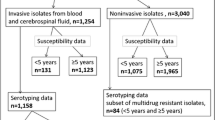Abstract
The emergence ofStreptococcus pneumoniae strains with decreased susceptibility to penicillin has been reported worldwide over the past 20 years. However, there are striking discrepancies in penicillin susceptibility among various European countries, suggesting that local conditions may affect clonal propagation or de novo selection of resistant strains. In the present study, data on penicillin resistance patterns, antibiotic use and mode of administration, and treatment compliance in five European countries (France, Spain, Germany, Italy, and the UK) were compared. High prevalence rates of penicillin-resistant pneumococci have been reported in Spain and France, where antibiotics are widely prescribed, and overall in Europe, patient compliance with more than 50% of oral antimicrobial prescriptions is inadequate. The low prevalence of penicillin resistance in Germany and the UK coincides with lower antibiotic consumption and better treatment compliance in these countries. Recent attempts to raise public awareness and to restrict and improve indications for antimicrobial agents have resulted in decreased pneumococcal resistance in Hungary and Iceland, suggesting that pneumococcal resistance can be reversed.
Similar content being viewed by others
References
Dowson CG, Hutchison A, Brannigan JA, George RC, Hansman D, Linares J, Tomasz A, Smith JM, Spratt BG: Horizontal transfer of penicillin-binding protein genes in penicillin-resistant clinical isolates ofStreptococcus pneumoniae. Proceedings of the National Academy of Sciences of the USA 1989, 86: 8842–8846.
Sifaoui F, Kitzis MD, Gutmann L: In vitro selection of onestep mutants ofStreptococcus pneumoniae resistant to different oral β-lactam antibiotics is associated with alterations of PBP2x. Antimicrobial Agents and Chemotherapy 1996, 40: 152–156.
Carsenti-Etesse H, Durant J, De Salvador F, Bensoussan M, Pradier C, Thabaut A, Dellamonica P: In vitro development of resistance ofStreptococcus pneumoniae to β-lactam antibiotics. Microbial Drug Resistance 1995, 1: 85–94.
Baquero F, Martinez-Beltran J, Loza E: A review of antibiotic resistance patterns ofStreptococcus in Europe. Journal of Antimicrobial Chemotherapy 1991, 28, Supplement C: 31–38.
Munoz R, Musser JM, Crain M, Briles DE, Marton A, Parkinson AJ, Sorenson U, Tomasz A: Geographic distribution of penicillin-resistant clones ofStreptococcus pneumoniae: characterization by penicillin-binding profile, surface-protein A typing, and multi-locus enzyme analysis. Clinical Infectious Diseases 1992, 15: 112–118.
Baquero F: Evolution de la résistance du pneumocoque en Espagne: un modèle prédictif. Médecine et Maladies Infectieuses 1994; 24: 241–246.
Geslin P, Fremaux A, Sissia G, Spicq C, Aberrane S: Epidémiologie de la résistance aux antibiotiques deStreptococcus pneumoniae en France. Réseau national du surveillance (1984–1993). Médecine et Maladies Infectieuses 1994, 24, Spécial: 948–961.
Reinert RR, Queck A, Kaufhold A, Kresken M, Lütticken R: Antimicrobial resistance and type distribution ofStreptococcus pneumoniae isolates causing systemic infections in Germany, 1992–1994. Clinical Infectious Diseases 1995, 21: 1398–1401.
Marchese A, Debbia EA, Arvigo A, Pesce A, Schito GC: Susceptibility ofStreptococcus strains isolated in Italy to penicillin and ten other antibiotics. Journal of Antimicrobial Chemotherapy 1995, 36: 833–837.
Ridgway EJ, Tremlett CH, Allen KD: Capsular serotypes and antibiotic sensitivity ofStreptococcus pneumoniae isolated from primary-school children. Journal of Infection 1995, 30: 245–251.
Lecomte T, Paris V: Consommation de pharmacie en Europe — Allemagne, France, Italie, Royaume Uni. In: Consommation de pharmacie en Europe, 1992. The Centre de Recherche d'Etude et Documentation en Economie de la Santé, Paris, 1994, p. 27–37.
Branthwaite A, Péchère JC: Pan-European survey of patients' attitudes to antibiotics and antibiotic use. Journal of Internal Medicine Research 1996, 24: 229–238.
Sclar DA, Tartaglione TA, Fine MJ: Overview of issues related to medical compliance with implications for outpatient management of infectious diseases. Infectious Agents and Disease 1994, 3: 266–273.
Bédos JP, Chevret S, Chastang Cl, Geslin P, Régnier B, and the French Cooperative Pneumococcus Study Group: Epidemiological features of and risk factors for infection byStreptococcus pneumoniae strains with diminished sensitivity to penicillin: findings of a French survey. Clinical Infectious Diseases 1996, 22: 63–72.
Nava J, Bella F, Garau J, Lite J, Morera MA, Mart C, Fontanals D, Font B, Pineda V, Uriz S, Deulofeu F, Calderon A, Duran P, Grau M, Agudo A: Predictive factors for invasive disease due to penicillin-resistantStreptococcus pneumoniae: a population-based study. Clinical Infectious Diseases 1994, 19: 884–890.
Baquero F: Trends in antibiotic resistance of respiratory pathogens: an analysis and commentary on a collaborative surveillance study. Journal of Antimicrobial Chemotherapy 1996, 38, Supplement A: 117–132.
Eisen S, Miller DK, Woodward RS, Spitznagel E, Przybeck TR: The effect of prescribed daily dose frequency on patient medication compliance. Archives of Internal Medicine 1990, 150: 1881–1884.
Greenberg RN: Overview of patient compliance with medication dosing: a literature review. Clinical Therapeutics 1984, 6: 592–599.
Holmes SJ, Morrow AL, Pickering LK: Child-care practices: effects of social change on the epidemiology of infectious diseases and antibiotic resistance. Epidemiological Reviews 1996, 18: 10–28.
Taboulet F: Présentation d'une méthodologie permettant de mesurer en quantité et de comparer les consommations pharmaceutiques. Journal d'Economie Médicale 1990, 8: 37–63.
Nowak R: Hungary sees an improvement in penicillin resistance. Science 1994, 264: 364.
Author information
Authors and Affiliations
Rights and permissions
About this article
Cite this article
Pradier, C., Dunais, B., Carsenti-Etesse, H. et al. Pneumococcal resistance patterns in Europe. Eur. J. Clin. Microbiol. Infect. Dis. 16, 644–647 (1997). https://doi.org/10.1007/BF01708553
Issue Date:
DOI: https://doi.org/10.1007/BF01708553




